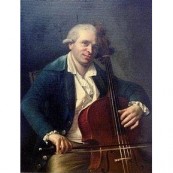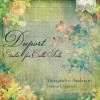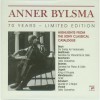Composers
Jean-Louis Duport (October 4, 1749 – September 7, 1819), sometimes known as Duport the Younger to distinguish him from his older brother (and teacher) Jean-Pierre (1741-1818), was a cellist and composer.
He is perhaps best known today for his 21 études for solo cello that constitute the final part of the "Essai sur le doigté du violoncelle et sur la conduite de l'archet" ("Essay on the fingering of the violoncello and on the conduct of the bow") (1806), a seminal work of cello technique. He also wrote six cello concertos.
In 1812, Jean-Louis returned to Paris, where he encountered Napoleon, who insisted on trying out Duport's Stradivarius cello, exclaiming, "How the devil do you hold this thing, Monsieur Duport?" Duport was so obviously afraid that Napoleon would damage it, that Napoleon laughingly returned it to the cellist's more careful hands. Actually, Napoleon had made a small dent in the ribs of the cello, which may still be seen in the instrument. It was later owned by Auguste Franchomme and also Mstislav Rostropovich.
Recently Added
Biography
Jean-Louis Duport (October 4, 1749 – September 7, 1819), sometimes known as Duport the Younger to distinguish him from his older brother (and teacher) Jean-Pierre (1741-1818), was a cellist and composer.
He is perhaps best known today for his 21 études for solo cello that constitute the final part of the "Essai sur le doigté du violoncelle et sur la conduite de l'archet" ("Essay on the fingering of the violoncello and on the conduct of the bow") (1806), a seminal work of cello technique. He also wrote six cello concertos.
In 1812, Jean-Louis returned to Paris, where he encountered Napoleon, who insisted on trying out Duport's Stradivarius cello, exclaiming, "How the devil do you hold this thing, Monsieur Duport?" Duport was so obviously afraid that Napoleon would damage it, that Napoleon laughingly returned it to the cellist's more careful hands. Actually, Napoleon had made a small dent in the ribs of the cello, which may still be seen in the instrument. It was later owned by Auguste Franchomme and also Mstislav Rostropovich.






